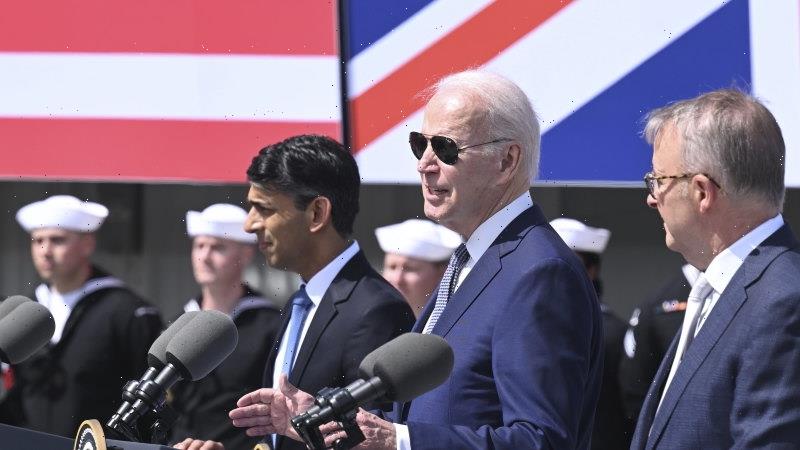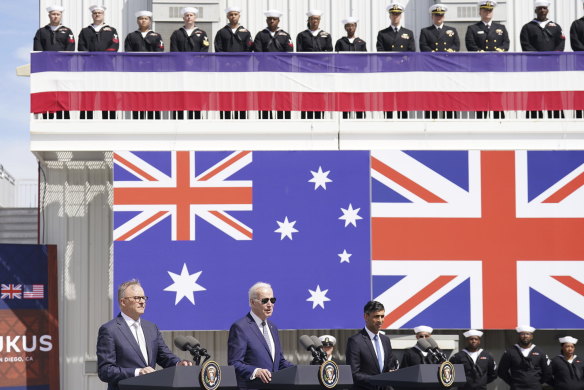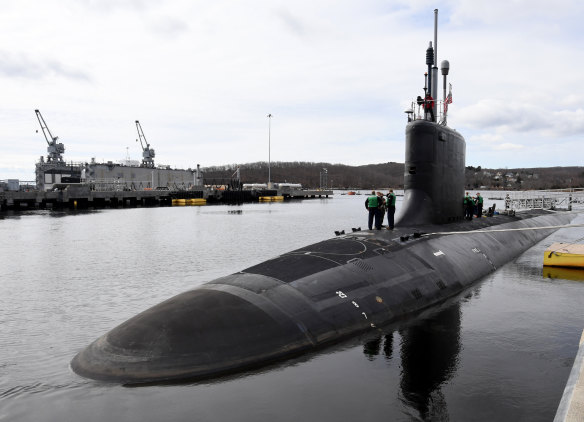
‘Whatever it takes’: Democrats and Republicans unite for AUKUS
March 15, 2023San Diego: Republicans and Democrats in the US Congress have thrown their weight behind the ambitious plan to help Australia acquire nuclear-powered submarines, vowing to do “whatever it takes” to make the AUKUS pact a success.
And state department officials say they have briefed China about the announcement, as tensions between Washington and Beijing continue to simmer over the $368 billion deal between Australia, the US and the United Kingdom.
Prime Minister Anthony Albanese, US President Joe Biden and Britain’s Prime Minister Rishi Sunak at Point Loma naval base in San Diego, US, on Monday.Credit:AP
“It’s no secret that our relationship with China is not as close as it was in the past,” said Mark Lambert, deputy assistant secretary for the department’s bureau of East Asian and Pacific Affairs.
“I would like to point out, though, that we did brief the Chinese about this AUKUS announcement in the hopes of promoting transparency.”
On Tuesday, Anthony Albanese joined US President Joe Biden and UK Prime Minister Rishi Sunak at a navy base in San Diego to outline the details of the three-way pact, designed to counter China’s economic and military advances in the Indo-Pacific.
Under the deal, Australia will buy at least three Virginia-class submarines from the US as it builds capacity to develop its own locally made nuclear-powered subs, sometime in the 2040s.
The Virginia-class attack submarine USS Delaware
However, questions remain about the lengthy time frame, the extraordinary cost to taxpayers, and the maze of US export control laws that must be reformed for America to share nuclear technology secrets with Australia.
Another concern is whether a future US administration could place the deal at risk, although Defence Minister Richard Marles said he was “confident” this would not happen, based on the US-Australia alliance that spans decades.
Bipartisan members of Congress have so far strongly endorsed the plan and the new chapter in the alliance between the three countries.
Among them is Democratic Congresswoman Sara Jacobs, a former foreign policy adviser to Hillary Clinton who travelled to Australia in October to learn more about AUKUS as part of a delegation with the House of Representatives’ Foreign Relations Committee.
“There is broad bipartisan consensus in Congress recognising the importance of the US-Australia relationship and we’re ready to do what it takes to make sure that AUKUS is successful,” she told The Sydney Morning Herald and The Age.
Republican Mike Gallagher, who co-chairs Congress’ so-called AUKUS caucus alongside Democrat Congressman Joe Courtney, also threw his weight behind Tuesday’s announcement and plans to use his new role as a head of a special committee on China to tackle the issue of export controls.
“Now we must act with urgency to not only fully resource and implement this agreement, but also make the necessary policy choices to make AUKUS as successful as possible,” he said.
US Congressman Mike Gallagher, who co-chairs the AUKUS working group.
And Senator James Risch, the highest-ranking Republican on the Senate Foreign Relations Committee, said that while he strongly supported the push for Australia to acquire new submarines, the Biden administration should also sharpen its focus on the second pillar of AUKUS, which aims to boost cooperation in areas such as quantum computing and artificial intelligence.
“While a credible undersea capability is a critical piece of this, it will take well over a decade to deliver additional submarines to the Indo-Pacific,” Risch said.
“The Biden Administration also needs to be laser-focused on the second pillar of AUKUS – advanced capabilities. This is where AUKUS will see its earliest and most impactful wins and get more capability into the region.”
The Albanese government describes AUKUS as the single biggest upgrade to the nation’s defence capabilities in history. The sweeping plan will begin with more visits to Australian ports by US submarines this year and British vessels from 2026, before a fixed rotation of naval power in Perth.
Over time, Australia will aim to build a new fleet of nuclear-powered submarines, jointly designed with the UK called the SSN-AUKUS. The vessels will consist of eight submarines fitted with vertical launch systems to fire cruise missiles. They will be made in Adelaide and start entering service in the 2040s.
In the meantime, Australia will buy at least three and up to five Virginia-class submarines from the US. But this will depend on approval from Congress, where some members have previously raised concerns that America’s industrial submarine base could be stretched “to breaking point.”
Kevin Graney, president of General Dynamics Electric Boat, which is one of two companies that make Virginia class submarines in the US, said he welcomed AUKUS and the attention it placed on “the importance of continuing to grow our submarine industrial base here in the United States.”
China, meanwhile, responded by warning that the countries involved were going “further down the wrong and dangerous path for their own geopolitical self-interest”.
However, Navy under-secretary Erik Raven said on Wednesday (AEST) that America’s security and prosperity were dependent upon unfettered access to the sea.
“We are at an inflection point, with critical choices to make to meet the pacing challenge posed by the People’s Republic of China, the acute threat of Russia, as well as the persistent threats of Iran, North Korea and other malign actors,” he said.
Charles Edel, the Australian chair of the Centre for Strategic & International Studies, a Washington-based think-tank, said: “This will be an enormous investment – budget-wise and politically – but it also holds out the hope of growing the collective capabilities of these three nations, further aligning their strategies, and increasing collective security across the Indo-Pacific region.”
Get a note directly from our foreign correspondents on what’s making headlines around the world. Sign up for the weekly What in the World newsletter here.
Most Viewed in World
From our partners
Source: Read Full Article





